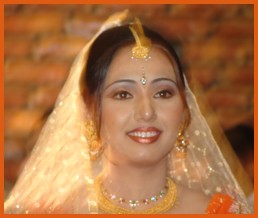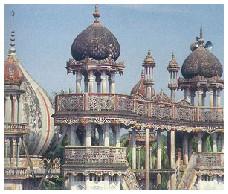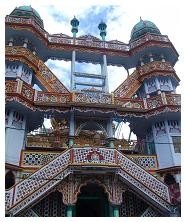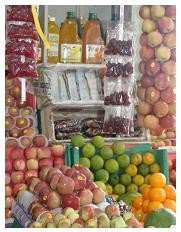|
|
|
|
|
|
|
|
|
|
|
|
|
|
|
|
|
|
|
|
|
|
|
|
|
|
| |
WORLDCOOK'S TRAVELS - CHITTAGONG (Bangladesh) |
|
|
|
Recipes from Bangladesh |
|
Travel to Bangladesh |
|
Travel to other countries |
 |
|
|
We
went to Chittagong to visit the wedding of our friends. The bride was the
most beautiful bride I have ever seen in my life, and obviously happy. The
first wedding I saw was an arranged marriage; the bride was sitting like a
porcelain puppet on a chair. She never even smiled once, notwithstanding
little nieces and nephews dancing on her lap and pulling her hair. She
looked like paralyzed with fear. This bride, as you can see for yourselves, is radiant and looks forward to her future. | |
 The population of Chittagong
is mixed, descending
from Arab, Afghan and Mogul origin, and even people from Portuguese
background still live there. The Chittagong dialect (Chatgaiyan Buli) is
very different from Bengali, even though the writing is the same. In this
dialect you can find a lot of Arabic words, as well as Portuguese and
Hindi words, and many names in Chittagong are of Arabic background.
Already in the seventh century, a Chinese traveler described Chittagong as
"a sleeping beauty emerging from mist and water". Part of
the city The population of Chittagong
is mixed, descending
from Arab, Afghan and Mogul origin, and even people from Portuguese
background still live there. The Chittagong dialect (Chatgaiyan Buli) is
very different from Bengali, even though the writing is the same. In this
dialect you can find a lot of Arabic words, as well as Portuguese and
Hindi words, and many names in Chittagong are of Arabic background.
Already in the seventh century, a Chinese traveler described Chittagong as
"a sleeping beauty emerging from mist and water". Part of
the city
 dates back from the beginning of the 13th century, when the
Muslims conquered Bengal and settled down in this nice and accessible spot
close to the sea. From the middle of the 16th to the middle of the 17th
Century, the Portuguese practically reigned Chittagong. The Moguls
conquered the city in 1666. In the 18th and 19th century, the British were
reigning India and its surroundings and Chittagong lost its first position
to Calcutta. Chittagong has many beautiful buildings, mosques and shrines
that show its long history. dates back from the beginning of the 13th century, when the
Muslims conquered Bengal and settled down in this nice and accessible spot
close to the sea. From the middle of the 16th to the middle of the 17th
Century, the Portuguese practically reigned Chittagong. The Moguls
conquered the city in 1666. In the 18th and 19th century, the British were
reigning India and its surroundings and Chittagong lost its first position
to Calcutta. Chittagong has many beautiful buildings, mosques and shrines
that show its long history.One of the mosques we found in Chittagong was the Shahi Jama-e-Masjid. This mosque dates back from 1670 but was enlarged in 1950. As it had been recently painted in extremel In the city there is another "place of worship", an artificial lake full of animals that look most like sea turtles. People told me that they actually are sea turtles and that it is a miracle that they live in the sea water. Part of the miracle is are obviously a crowd of Bangladeshi, who try to feed the turtles from a stick, believing that your wishes will be granted when the animal accepts the food. They believe that the animals were created by God, when the pious Bustam was plagued by evil spirits upon arrival in this town when he said his first prayers, and demanded his God to find a solution for the spirits. Becoming a water turtle and being fed rubbish on sticks seemed an apt punishment.  During
the Second World War, the town was used as a military base by the British,
and consequently got bombarded by the Japanese. The Burmese front was all
too close to Bangladesh and the river Quai around the corner. The World
War II memorial cemetery has graves of European, Australian as well as
Japanese soldiers. We even found one grave of a Dutch boy, his name
indicated he came from Indonesia. Sadly, most of them were barely 20 years
old when their live was brutally ended. During
the Second World War, the town was used as a military base by the British,
and consequently got bombarded by the Japanese. The Burmese front was all
too close to Bangladesh and the river Quai around the corner. The World
War II memorial cemetery has graves of European, Australian as well as
Japanese soldiers. We even found one grave of a Dutch boy, his name
indicated he came from Indonesia. Sadly, most of them were barely 20 years
old when their live was brutally ended.
 Chittagong is Bangladesh's largest seaport, and all the export and import over sea go through this harbor. This area used to be a Portuguese enclave and it is still mainly a Christian area. The old city is around the harbor and it is a very nice area to walk around, full of fish sellers and shops with nets and other items fishermen might need; there is also a large fish market. Furthermore, it is also a commercial and manufacturing center and there is a lot of activity going on. This is probably the reason why many expats are temporarily or permanently stationed here. There are also many schools, universities and colleges. | |
|
|
|
|
| |